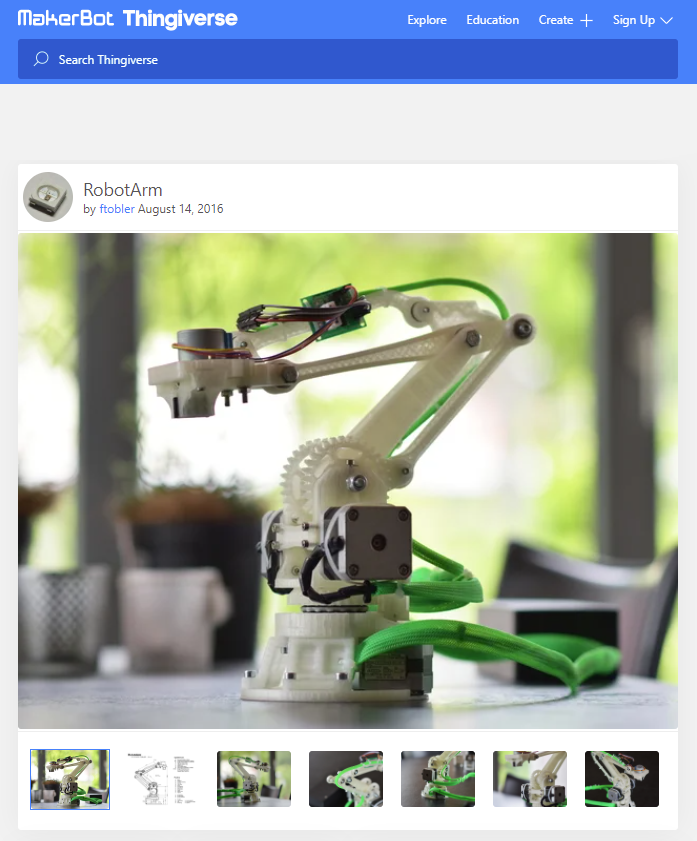-
1 Introduction
-
2 Theoretical concepts
-
3 The printing process
-
4 Arm assembly and electronics
Where to get 3D objects? The STL repositories
In this lesson, the most used object banks will be explained to the students. By far the most widely used STL object bank is Thingiverse. In it you can find objects classified by categories:
- Art
- fashion
- Gadgets
- Hobby
- Hosehold
- Learning
- Models
- Tools
- Toys & Games
- Other
This is a repository where you can find a large number of objects. In addition, you can find objects that fulfill part of the desired functionality and we can modify them to meet our needs. In other years we have created in this subject a working group to print and create objects related to biology and we have printed mitochondrias, chloroplasts, etc.
Licenses of use. Before carrying out the search, an enumeration of the licenses of the different STL objects that can be found in thingiverse will be made. For this, we will base ourselves on the information on the following website: https://creativecommons.org/licenses/. The search will be done taking into account the license and reminding the students that it is important to attribute the work to the creator.
The activity that is proposed with the students is to do an exhaustive search of the different objects related to robotic arms and after a complete search it has been decided among all the class members to use the robotic arm of Florin Tobler. The user license has been analyzed to avoid problems and it has a CC_NC license
CC BY-NC. This license lets others remix, adapt, and build upon your work non-commercially, and although their new works must also acknowledge you and be non-commercial, they don’t have to license their derivative works on the same terms.
More information about this license can be found at: https://creativecommons.org/licenses/
The object in question is shown in the following figure:

In addition to the STL of the different parts, you can find STP files which will show the assembly process to follow.
List of STL repositories:
Thingiverse (http://www.thingiverse.com/). In this site you can find many objects. No registration is required to download. The site also allow uploading your 3D objects and then creation of apps with their API in order to interact with the site.
GrabCAD (http://grabcad.com/library/category/3d-printing/software/stl?per_page=20). GrabCAD is a CAD user community. This community has over one million registered users and over 300,000 CAD files available including STL files. Registering is compulsory to download models.
TurboSquid (http://www.turbosquid.com/Search/3D-Models/free/stl). TurboSquid was founded in 2000 and aims to produce 3D models for industry. There are more than 300,000 models to download. Just search by keyword or browse the categories to find the model wanted to download. As in GrabCAD, you must be registered to download models.
SketchUp (https://3dwarehouse.sketchup.com/). SketchUp is designing 3D objects software. With this software you can design and share 3D models with the SketchUP community. There are two kinds of software, the SketchUp and the SketchUp Pro. The SketchUp Pro has extra functionality and is recommended for advanced use.
3D Via (http://www.3dvia.com/search/?search[format]=stl&search[file_types]=1). is a web where more than 350,000 users share STL files collaboratively. There are many models grouped by categories.
The 3D Studio is one of the largest 3D model database. The only problem is that you have to pay for the models that you want to download.
Yeggi (http://www.yeggi.com/) is a search engine for STL models. There are thousands of downloadable models and the database is updated daily with more and more models.
STL File (http://stlfile.com/) is a site where you can find objects to download. We recommend to go to STLdownload.com. STLdownload.com is a search engine of STL files.
STL Download (http://stldownload.com/). STL is a web where you can download and upload STL models. Currently there are lots but the database is growing.
